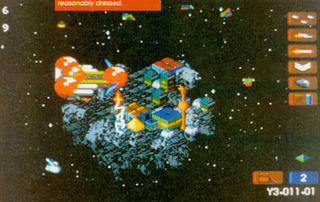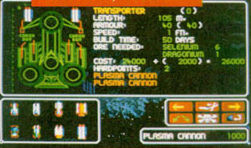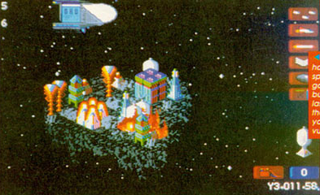Prerelease:K240
This page details pre-release information and/or media for K240.
K240 was first envisioned as a sequel to planetary colony management sim Utopia: the Creation of a Nation (1991), adding greater focus on the game's military strategy aspect. Originally intended for release in late 1992, the initial design document proved too ambitious, and many changes were made before its release in May 1994.
Contents
Development Timeline
1991
- September - Utopia: the Creation of a Nation is released for Commodore Amiga, following approximately one year in development. The September issue of CU Amiga magazine reviews the game, rating it 94% and teasing a sequel.
- November - Peter Lee interviews Utopia lead developer Graeme Ing for Amiga Action #28 (Jan 1992; magazine articles were written approximately six weeks before cover date). Ing announces Utopia 2. The game is still in the planning stage, and a contest offers signed copies of the game in exchange for innovative ideas. Its tentative release date is late 1992.
1992
- May - Development on the new game finally begins. It appears to have been delayed due to the author working on the expansion disk for Utopia. (Source: The One #59)
- December - K240 misses its original scheduled release date of late 1992. (Source: Amiga Action #28)
1993
- June - The One #59 (Aug 1993) announces a release date of December 1993. Screenshots in that issue show most of the game's core features and graphics have been implemented. Minor differences from the final release include some ship and building graphics, a different date format, and different ship statistics.
- July - Just as The One #59 goes to press, the game is given a title of K240 - The New Worlds. The game only has seven of the final eight ship types. (Source: Amiga Action #48)
- September - K240 misses another scheduled release date. (Source: Amiga Power #30)
- December - K240 misses another scheduled release date. (Source: The One #59)
1994
- January - A mostly-complete one-disk demo version of the game is produced for distribution with the March issue of CU Amiga magazine as Coverdisk #77. All ships now have their final graphics. Differences with the final game include some building graphics, cheat codes have been removed, and brighter management screen backgrounds. The demo promises a March 1994 release date.
- February 18 - Icon file written to disk. Finishing touches are being put on the game.
- March - K240 misses another scheduled release date. (Source: CU Amiga Coverdisk #77) A pre-release build of K240 is distributed to magazines for review. It lacks the 3D rendered outro graphics which appear in the finished game.
- March 2 - Hard disk installer added to K240 Disk 3, based on the HeroQuest 2: Legacy of Sorasil installer. Final touches are being added to the game.
- April 29 - Icon file added for the main game. Also on this day, Commodore International declares bankruptcy, following poor sales of the Amiga CD32 console. Gremlin would subsequently release future games on platforms other than the Amiga line.
- May 16 - A checksum program is written to check that all of the game's files are correct.
- May 20 - The retail build of K240, v1.886, is completed.
- May 26 - A pirate copy of the game is produced which strips the copy-protection.
- June 7 - A patched build, v2.000, is completed. This fixes a bug that caused game crashes associated with fleet movement.
Known pre-release builds
Three major pre-release versions of the game were detailed in contemporary press:
- An alpha version of the game. A set of screenshots were distributed to various magazines and appeared in preview articles as early as The One Amiga 59 (Aug 1993). Screenshots from this set also appeared on the back of the game box. Most of the game's features and graphics appear to be complete at this point. It probably dates to June or July 1993.
- A probable later alpha, depicting cheat codes which appear in the finished game. Screenshots first appeared in Amiga Format #56 (Feb 1994), likely dating it to around December 1993. It appears to slightly pre-date the CU Amiga K240 demo (March 1994).
- A magazine review build which was sent to several major magazines. It is nearly complete except for missing outro graphics and French language translation, and based on the reported inclusion of a hard disk installer it was probably completed around March 1994.
Graphical Changes
A review copy given to The One Amiga magazine shows a different background image on the game's victory screen. It uses a version of satpic.mgl, normally used for the game's Intel management screen. It is possible that the 3D rendered graphics used on the outro screen were a late addition, and were not completed in time for the review copy.
| K240 win screen in magazine review copy | K240 win screen in final release |
|---|---|
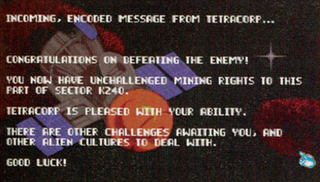 |
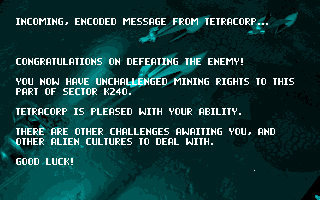 |
Some changes were made to ship graphics between alpha and review copy. Most notable is the Transporter, which originally appeared to be built with large orange spheres. The wireframe diagram of the Transporter on the ship construction screen matches this design. The final game entirely redesigns this ship. Most Terran ships change from brightly-coloured to a more greyish design reminiscent of Star Trek: The Next Generation, although "garish" ship color schemes are still mentioned in the ship's manual. We can also see a slightly different battleship design.
Several building sprites were changed very slightly. The most radical change appears to be a green tiered building, which does not appear in the finished version, at least not as a Terran building. The Environment Control is also different from its final version, and this form also appears in the CU Amiga demo, meaning it was changed at the last minute. The Construction Yard sprite was similarly revised after the demo version. The shape on the top of the Resiblock was also changed between the alpha and the demo version.
Screenshots appearing in magazine advertisements, reflecting a later alpha which pre-dates the March 1994 demo, show a much older design for the Sci-Tek blueprint purchase screen. The general layout appears to be the same as the final version, as do the prices, wireframe graphics, and item descriptions. However, the font and background differ.
| K240 blueprint screen in magazine advertisement | K240 blueprint screen in March 1994 demo |
|---|---|
 |
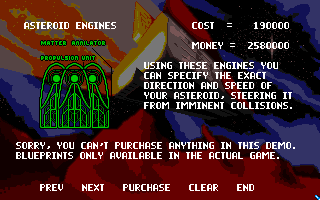 |
Gameplay Changes
Many planned gameplay features were removed due to time constraints and technical limitations. Lead programmer Graeme Ing, in interviews with CU Amiga and The One Amiga magazines, noted that the original specification would have taken five years to develop instead of two.
Alien scenarios originally intended to feature scenario-specific sub-goals, which could include destroying shield generators, finding specific resources before the enemy, disabling convoys, or locating bases. Ultimately, the only scenario goal to appear in the final game was the Swixaran asteroid cloak, which required players to destroy cloaking generators at two alien asteroids to allow the alien home asteroid to become visible.
Null modem multiplayer was intended. However, it was discounted early on due to the large amount of data necessary to maintain game state.
A preview of K240 in Amiga Power #30 (Oct 1993) suggests the game would have a technology research system. In the final game, technology is acquired by purchasing blueprints from a megacorporation named Sci-Tek. Early 1993 screenshots are missing the Sci-Tek button, which may suggest that the blueprint feature was added later in development. However, it may simply be that the Sci-Tek button had not been added to the main screen.
As depicted in the original set of alpha screenshots, an earlier design for the Transporter ship has different statistics: it builds in 50 days instead of 144, and Plasma Cannon costs only 1,000 credits instead of 9,000. A fleet listing depicts impossibly high ship armour values, including a Combat Eagle with 150 armour and an Assault Fighter with 91 (normal maximum values are 130 and 70 respectively). Both screenshots appear on the back of the game box, as well as in Amiga Action #48 and other magazines.
An unused ship known as the Orbital Shuttle remains in the final game code. Its purpose is unknown.
A number of factors suggest that the Orbital Space Dock was added much later in the game's development. Cheat code strings in the March 1994 CU Amiga demo read "ENTER SHIP 1-7", while the final release's cheat code reads "ENTER SHIP 1-8", with 8 being the Orbital Space Dock. A preview in Amiga Action #48 (Sept 1993) mentions a number of 7 ship types, suggesting an 8th was not added until later. The name string for Orbital Space Dock also appears significantly later in the string index than the other ships. The OSD's 3D render was also not ready in time for the game's manual. One speculation is that the OSD was inspired by the space station from Star Trek: Deep Space Nine, which first aired in the UK on August 1, 1993.
Alpha screenshots depict a slightly different date format, beginning "Y3" (presumably for "year") instead of "E2" (presumably "Empire").
The magazine review build of the game only included English language. French magazines Amiga Dream and Joystick printed only screenshots in English, with Joystick's reviewer admitting that the review copy lacked a French translation, although this was promised for the final release. Amiga Format's reviewer also complained that the game did not support multiple floppy disk drives.
Debug Features
The alpha screenshots depict two numbers which appear in the top-left corner of the screen. These do not appear in the final version of the game, and probably represent some debug feature.
A single screenshot Amiga Format 56 (Feb 1994) depicts a button layout equal to that setup by the PANEL cheat, showing that cheat codes for testing purposes already appeared in the game by this stage. An unused text string from the CU Amiga magazine demo of K240 (Mar 1994) refers to cheat codes as "help code", suggesting perhaps they were initially triggered by pressing the Amiga's "Help" key.
An alpha screenshot in Amiga Action #48 appears to show an asteroid with the maximum ten of each missile, including the Mega missile, which requires rare ore and is unlikely to have been acquired legitimately. The final version of the game includes the cheat code "ICBM" which gives the player 4 of every missile. A screenshot depicting the 4-missile version of this cheat (likely included as aliens have a missile limit of 5) appears in a magazine advertisement which appeared after the game's release, and which includes screenshots from the later alpha. These screenshots can be identified as non-final due to the inclusion of the screenshot which appeared in Amiga Format 56 (Feb 1994), the appearance of the old Construction Yard sprite, and the inclusion of Sci-Tek.
